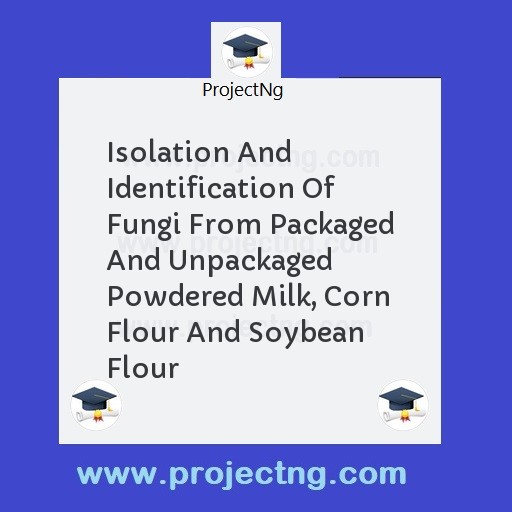Isolation And Identification Of Fungi From Packaged And Unpackaged Powdered Milk, Corn Flour And Soybean Flour
Microbiology Project Topics
Get the Complete Project Materials Now! »
ABSTRACT
This research was carried out for the isolation and identification of fungal spoilage organisms in foods. The foods studied are, packaged and unpackaged powdered milk, corn flour and soybeanflour. These samples were bought from Enugu main market (Ogbete) using sterile nylon bags for each samples and taken to the laboratory for analysis. One gram of each sample was put into nine (9) ml of sterile water, tenfold dilution was carried out upto the fithth srerile test tubes to reduce microbial load. Spread plate method was used by taking 0.1 from each dilution unto sterile prepared Sabouraud dextrose agar plates, the plates were incubated atleast for 48hrs for growth to occur. Representative growths from the plates were then sub cultured on agar slant to obtain pure cultures for identification. Slide culture technique was use for proper identification of the filamentous fungiand incubation was at least four (4) - six (6) days. Lactophenol blue was use to stain the fungi growth on the slide and the cover slip which was viewed under the light microscope. From this research carried out genera of fungi isolated were, Aspergillus, Fusarium, Pennicillium andMucor. The dominant genus isolated was Aspergillus. The most contaminated food product from this research is the corn flour sample which was contaminated with all the fungal genera identified. The fungi isolated are known to be pathogens of man some species of aspergillus are known to produce toxins which is the aflatoxin causing the diseases known as aflatoxycosis in man. Also some species of penicillium and fusarium are known to produce mycotoxins which causes human diseases. These food products can be contaminated due to daily exposure to air as fungi spores are known to be present in large number in the air making it easy for them to invade exposed foods.
TABLE OF CONTENT
Cover page………………………………………………………………………………..i
Tittle page……………………………………………………………………………..….ii
Approval page ……………………………………………………………………...……iii
Dedication …………………………………………………………………………….....iv
Acknowledgement …………………………………………………………………….....v
List of tables……………………………………………………………………………..vi
List of figures …………………………………………………………………………..vii
Abstract …………………………………………………………………………………vii
CHAPTER ONE:
1.0 Introduction …………………………………………………………………..….... 1
1.1Aim……………….…………………………….…………………………….……….3
1.2 Objective……………….….……………………...…………...……………….…….3
CHAPTER TWO
2.0 Literature review……………………………………………………………………4
2.1 Fungal agents ……………………………………………………………….….. 4
2.2 Fungal activities on food …………….…………………………………..... 8
2.3 Milk and the fungi spoilage ……………………………………………..... 15
2.4 Soybean and the fungi spoilage …………………………………………... 18
2.5 Corn and their spoilage fungi ……………………………………………...21
CHAPTER THREE
3.0 Materials and methodology ……….…………………………………….. 23
3.1 Reagents ………………………………………………………………….23
3.2 Sample collection …………………………………………………………23
3.3 Sterilization of glass wares ……………………………...………………..23
3.4 Preparation of culture media ……………………………..……………...23
3.5 Preparation of samples …………………………………………………….24
3.6 Spread plate method…………………………………………………….. 24
3.7 Isolation of pure culture ………………………………………………… 24
3.8 Identification of isolates ………………………………………………… 24
3.9 Cultural characteristics...………………………………………………… 25
3.9. Use of slide culture techniques….…..…………………………………… 25
CHAPTER FOUR
4.0 Result.………………………...………………...………………….………27
5.0 CHAPTER FIVE
5.1Discussion………………………..…………………………………………….…33
5.2 Conclusion ……………………………………………………………………..36
References…………………………………………………………………………….
CHAPTER ONE
INTRODUCTION
Food products are a rich nutrient source that can attract both bacterial and fungal colonizers. Pitt et al (2009).As such, the food product can be regarded as an ecological resource. Colonization with a number of food-borne microorganisms is beneficial with respect to nutritional value and prolonged storage of the food product, which is known as food fermentation in other case. After successful colonization of the product, its nutritional properties are altered. Samson et al. (2004).When the nutritional value, structure, and taste of the product are negatively influenced, this colonization is called food spoilage. It can be accompanied by the production of toxic secondary metabolites which may result in serious medical problems (Dijksterhuis et al.,2007). These two aspects of food colonization are two sides of the same coin. Food spoilage is a major threat for our food stock and is responsible for enormous losses Pitt et al., (2009).
Fungi are the main degraders of the sturdy plant cell wall components that otherwise would accumulate within the ecosystems of the world. Prior to spoilage, the fungi can be present on or inside of the crop in low numbers, or as survival structures. Spoilage fungi can also be introduced to an empty habitat if the food is previously treated by pasteurization treatments. Food products include two main groups, which are living crops and processed food (Karlshøjet al.,2007).
Colonization of food products is hence very diverse. The relationship between the living crop and fungi can be illustrated. Then the association of fungi with different types of processed food is described. Preservation techniques make the food product a difficult environment to colonize, although it is also a rich medium. Only fungi (Springer-Verlag et al 2013) that can survive certain adverse conditions including high osmolarity and heat can successfully spoil processed food. Samson et al. (2004) provide overviews on the taxonomic description and specificity of food spoilage fungi, Dijksterhuis et al (2007) highlight numerous aspects of the relation between food and fungi including spoilage and fermentation.
AIM AND OBJECTIVES
This research is aimed at isolating and identifying fungi spoilage organisms in packaged and unpackaged milk, soybean flourand corn flour
OBJECTIVE
To isolate fungi spoilage organisms associated with packaged and unpackaged powdered milk, corn flour and soybean flour
To identify the isolated spoilage organism associated with the samples.
Be the First to Share On Social

Enjoying our content?
Don't miss out on new videos! Subscribe to our YouTube channel for more awesome content.
Subscribe Now!













